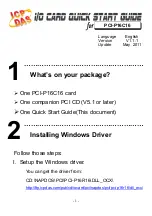
Appendix A: Troubleshooting Guide
43
Appendix A: Troubleshooting Guide
Problem:
You are running Windows 2000 or XP and your computer
spontaneously reboots on you.
Solution:
You have probably experienced what Microsoft calls a “bug check”, but
what everyone else calls the Blue Screen of Death (BSOD). The default setting for
the BSOD is not to show the BSOD, but to reboot the computer. This isn’t very
helpful for tracking down problems. If you are experiencing blue screens, here’s
how you can help us track it down (these are for Windows XP, but Windows 2000
is similar):
•
Select Start/Control Panel/System
•
Go to the Advanced tab and click on the “settings” button in the “Startup
and Recovery” section
•
Uncheck “Automatically restart”
•
In the “Write debugging information” section select “Small memory dump”
from the dropdown box
•
Click OK
Now, next time you get a blue screen, look at it. See if the crash occurred in
echo3g.sys; if it did, then it’s probably something we need to fix. Restart your
computer and find the most recent .dmp file – this is the memory dump. It’s
probably in C:\WINDOWS\Minidump. Zip up this .dmp file and send it to
along with a description of how it happened. This
will really help us track down problems. Unfortunately, Windows Me does not
save crash dumps.
Problem
: You are unable to get your DAT recorder to recognize the S/PDIF
output.
Solution:
Digital information is transmitted in either of two modes, “professional”
or “consumer.” The
professional
mode is usually implemented in devices that are
likely to be used in professional recording environments, whereas the consumer
mode is commonly implemented on equipment designed for home use in the
consumer market. The primary difference between the two modes is in the
implementation of the SCMS copy protection bit, which, in the consumer format,
prevents the user from making digital copies of a digital copy. In most professional















































